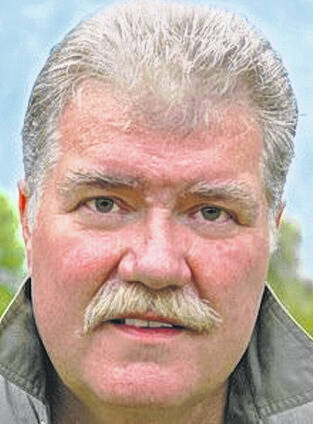
By James McGuire
Contributing columnist
It was dark and numbingly cold when I stepped outside with the dog. The thermometer near the doorway read a meager 20˚F.
Dawn was yet an hour away. No hint of precursory light graced the eastern horizon. Looking up, through the big sycamore’s pale tangle of bare limbs, a handful of stars glittered like shards of ice in the ebony sky. Outshining them all was the dominating beacon of brilliant Jupiter.
I shivered and tried to burrow deeper into the old blanket-lined canvas chore coat, making a mental note to dig out my goose-down parka from the back closet.
Forget any tidy astronomical technicalities of a yet-to-come solstice. Autumn was over; kicked to the curb. I didn’t need an official pronouncement or sanction from any calendar or almanac to tell me we’d entered a new season! December—the year’s twelfth and final month—had moved in and taken charge. And winter had followed along.
Winter was definitely here!
Both a new month and a new season seemed indisputable facts. But as usual, the realization of their dual arrival left me feeling decidedly startled.
How do they always get here so quickly once Thanksgiving has passed?
Perhaps we simply become distracted by all the seasonal busyness—a sort of slight-of-hand diversion that keeps us from paying proper attention to time’s relentless passage. Thus occupied, the new month and metamorphosing season sneak in amid the shuffle.
What I know is that time appears to accelerate. From here onward until after New Year’s Day, the intervening weeks and days whirl past like dry leaves before a wild north wind.
Still, regardless of whether the fact of December’s advent is long expected or catches us entirely by surprise, its presence is as welcome as it is necessary. For like those three wise men of long ago who followed the holy star, December comes bearing gifts.
December is the end consequence of our annual circular journey; the finish-line month, and an elemental logical conclusion to all that preceded.
When we placed that new calendar on our wall last January, we set out on a well-worn pathway, prescribed by the heavens—a journey as ancient as the planet.
The trail led first through winter’s heart of snow and cold, ice and wind; past the burgeoning greenery of spring, with pastel wildflowers and lilting birdsong; into summer’s lush, cicada-loud heat; and finally to autumn, mature, ripe, exquisite in a patchwork robe of scarlet and gold.
Now, here we are again—almost back to where we began. December’s paradoxical point of resolution—start and finish, beginning and end.
But, you protest, the year doesn’t begin until January. All our fancy calendars and almanacs say so!
I’d counter that nature says otherwise. For me, it’s pretty hard getting around the unassailable fact of the winter solstice.
Since the latter part of June—and the passage of the year’s counterpart summer solstice—our days have been growing shorter. Not by much at first; mere minutes—just a few drips and dribbles.
Practically unnoticeable. Nothing to yet be alarmed about.
But even teensy-tiny losses—those pesky dribbles— have a way of adding up. By the time of the autumnal equinox, the light loss does, indeed, become noticeable. Days are unquestionably shorter—a problem that keeps getting worse. Daylight shrinks at an ever-faster clip. The dribble increases to a trickle and soon swells into a steadily growing stream.
While June’s days had been filled with fifteen-plus hours of blessed sunlight—by contrast, dim December barely manages nine. No wonder the ancients feared these darkening times!
We moderns, with our panaceas of science and logic, simply can’t begin to understand how big a deal this winter solstice used to be—how it shaped cultures and influenced history. But it explains why many of the old texts often refer to December as the “turning point of the year,” or the year’s “hinge month.”
Some even go so far as to christen December as being the most important month of the year. Why? Because the winter solstice rekindled hope—and hope is a cornerstone necessity for enduring life.
I’ve long suspected some of us are still attuned to those old rhythms. Days shorten and a restless pinging begins deep in the primitive recesses of our not-quite-civilized brains. Despite our contemporary sensibilities, the tone persists—a primeval warning, bringing with it a concurrent anxiety and gnawing dread.
Then comes the solstice. Daylight’s loss slows, stops, reverses. The bucket of light—and hope!—begins refilling.
Ahh-h…No more pinging.
December’s start often also marks the nominal start of winter—at least weather-wise. The recent 20˚F morning proved that unequivocally.
I’ll admit I’m prejudiced. But from a naturalist’s viewpoint, I think the old way of dividing seasons made more sense. In that bygone way of calculating, December was the middle of winter, not its barely nominal beginning. Midwinter logically fell on the shortest day of the year—the winter solstice—just as the counterpoint solstice, occasioning the year’s longest day, hosted midsummer.
Still, in the end, such matters are trivial, issues of hairsplitting terminology. December’s timetable is not wrought by man. Instead, it is written in the gleam of stars in an ebony sky, the silver spill of moonlight across a frozen pond, the filigree of ice on a windowpane.
What’s important is that we don’t miss the beauty. I welcome both December and winter.
But I sure gotta dig out that parka!
Reach the writer at [email protected]


